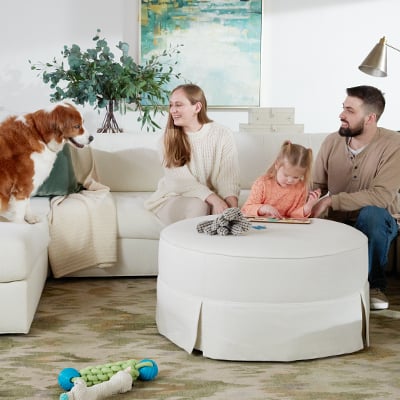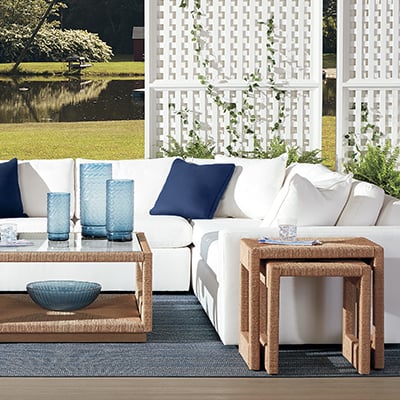upholstery fabric & leather
buying guide
No sofa, sectional, or accent chair frame is complete until it’s dressed in the perfect fabric or leather. Whether you’re someone who prefers neutral colors or looks for something beautiful and bold, we have tips to help you select the fabric or leather that’s right for you.
We suggest starting with two considerations: how it looks and how it wears. If you’re just looking for fast facts on a particular fabric or leather, you can jump to our fabric and leather quick guide.
How it looks
The fabrics and leathers you select for your room will help set your room palette, define how bold or subtle you want it to be, and add the textural details that will give your space a true designer look.
Work with your room palette

tonal
Tonal palettes are primarily shades of a single color, often with neutrals added. A tonal palette can feel expressive, like this vibrant teal formal living room, or serene when the colors are lighter and less saturated.

high contrast
Opposites attract in both real life and interior design. A dark gray and ivory contrast, as shown in this stormy yet sophisticated living room, feels energetic and bold even though the colors are neutral.

gentle contrast
Color friends that are near one another but just a little different, like this beige and blush living room, can be calming on their own—or they can be a canvas for here-and-there pops of contrasting hues.
A note on white fabrics: A crisp white fabric can be a fabulous design element—but keep in mind that white fabrics are less opaque than colored fabrics. If you tailored a stretchier white fabric over a featherblend cushion, for instance, the feathers could subtly show through.
Pick your patterns
Quick tips for mixing patterns
Consider texture and sheen
Fabrics and leathers have both visual and tactile texture, and these contribute to the look and feel of your space.
Did you know that many of our fabric sofas come standard with pillows that match the sofa fabric, and we can make even more decorative pillows from many of our upholstery fabrics? Ask your Ethan Allen designer about all your custom pillow options.
How it wears
Fabrics and leathers have to do more than look good—they also have to work for your lifestyle and how you use your room.

Formal, low-traffic spaces
You can use almost any fabric or leather in a low-traffic area since it won’t experience as much wear and tear, so break out those fine velvets and natural leathers—with the right care, anything you love will be right at home.

Pet- and kid-friendly spaces
Opt for fabrics and leathers designated for heavy use, i.e., look for “rated for heavy use” online or on the Design Center tag. You can also choose a light use leather that’s designed to show scratches and wear—but before you invest, be 100% confident that you’re comfortable with your leather showing signs of use.

Outdoor spaces and sunrooms
Choose indoor/outdoor fabrics for furniture that’s under the open sky or not completely surrounded by walls. In a sunroom or walled space, you can use indoor fabrics, even on outdoor furniture—just keep in mind that the upholstery wouldn’t be covered by our warranty.
Comfort wrinkles develop on every fabric and leather as the material stretches and pools to conform to your body. You can select firmer cushion fills and flip your cushions regularly to postpone the development of comfort wrinkles, but the effects of time are inevitable—they will appear.
Fabric & Leather Quick Guide
We offer many swatches online, but if an online swatch order isn’t available for the fabric you’re most interested in, visit a Design Center and ask to see any of our fabrics or leathers up close.
YOU INVESTED. GET PROTECTED.
When the unplanned happens to your furniture, a furniture protection plan can help. It goes beyond our warranty to cover your furniture for up to five years (see terms and conditions for complete details of what’s covered). Learn more >
Frequently Asked Questions
There’s a grade assigned to each fabric in your collection. What does that mean?
A fabric’s grade corresponds with its price point, which is partially determined by how much it costs to make the fabric. A grade doesn’t necessarily correspond with a fabric’s quality or its durability in a particular situation.
We offer hundreds of fabrics and leathers at a range of price points—and sometimes, the less expensive fabric may actually be the most beautiful, durable choice for a particular piece of upholstery, or for your lifestyle. Our interior designers are always available to help you make the right selections.
Why can’t certain fabrics be used for tufted headboards or for certain pieces, like recliners?
At Ethan Allen, we hand-tailor all our upholstery, which means that the people who work with our fabrics and leathers have expertise—and our craftspeople will be the first to tell you that not every fabric is suitable for every situation or type of upholstery.
Some fabrics, for example, may work for a deeply tufted application, like a sofa cushion, but they would have too much stretch to be tufted in a shallow application, like a fabric headboard; the fabric would be so loose that the tufts would fall open. Fabrics like velvet or chenille, with their cut pile, would show wear and tear when subjected to the constant motion of a recliner. That’s why certain customizations and/or fabrics aren’t available on every type of Ethan Allen upholstery.
What about water- or stain-repelling fabrics and leathers?
Most people want to live in their homes, not treat them like museums, so the thought of water- or stain-repellent fabric sounds appealing. Unfortunately, many of these fabrics are coated with harmful perfluoroalkyl or polyfluoroalkyl compounds—also known as PFAS.
As we have learned more about the effects of PFAS on our environment, Ethan Allen has transitioned away from upholstery fabrics that contain these coatings. Instead, we are working to introduce fabrics that offer some of the same protective characteristics, either through safer technologies or by using fabrics that have naturally stain- and water-repellent yarns. Fabrics with these labels are also GREENGUARD Gold Certified:



Is it okay to buy one upholstery piece in one fabric now and get a matching piece later?
If you purchase a chair in fabric or leather one year and plan to purchase a second piece in the same fabric or leather a year or two later, you may discover that either 1) the fabric you originally chose has been discontinued or 2) even in the same fabric, the chairs may look slightly different because the fabric or leather went through the dyeing process at different times.
When you receive a piece of upholstery from Ethan Allen, it comes with a fabric or leather swatch, which we recommend keeping in case you want to refer to it later. You can take the swatch to an Ethan Allen designer if you want to purchase coordinating upholstery in the future; your designer can help you find your original fabric or leather, assuming it’s still active, or work with you to find the best available match.
If potential differences are going to bother you, it may be a good idea to purchase the upholstery for your room at the same time. We offer financing† if you’d like to spread out the cost over time. (†Restrictions apply. Click here for details.)
Ready to shop?
For inspiration, browse our fabric & leather library.
Need advice on buying a sofa, chair, or sectional? Check out our living room seating buying guide.
If you have specific questions, click Designer Chat, or call a Design Center—our designers’ services are always complimentary.
Did you find this useful?

